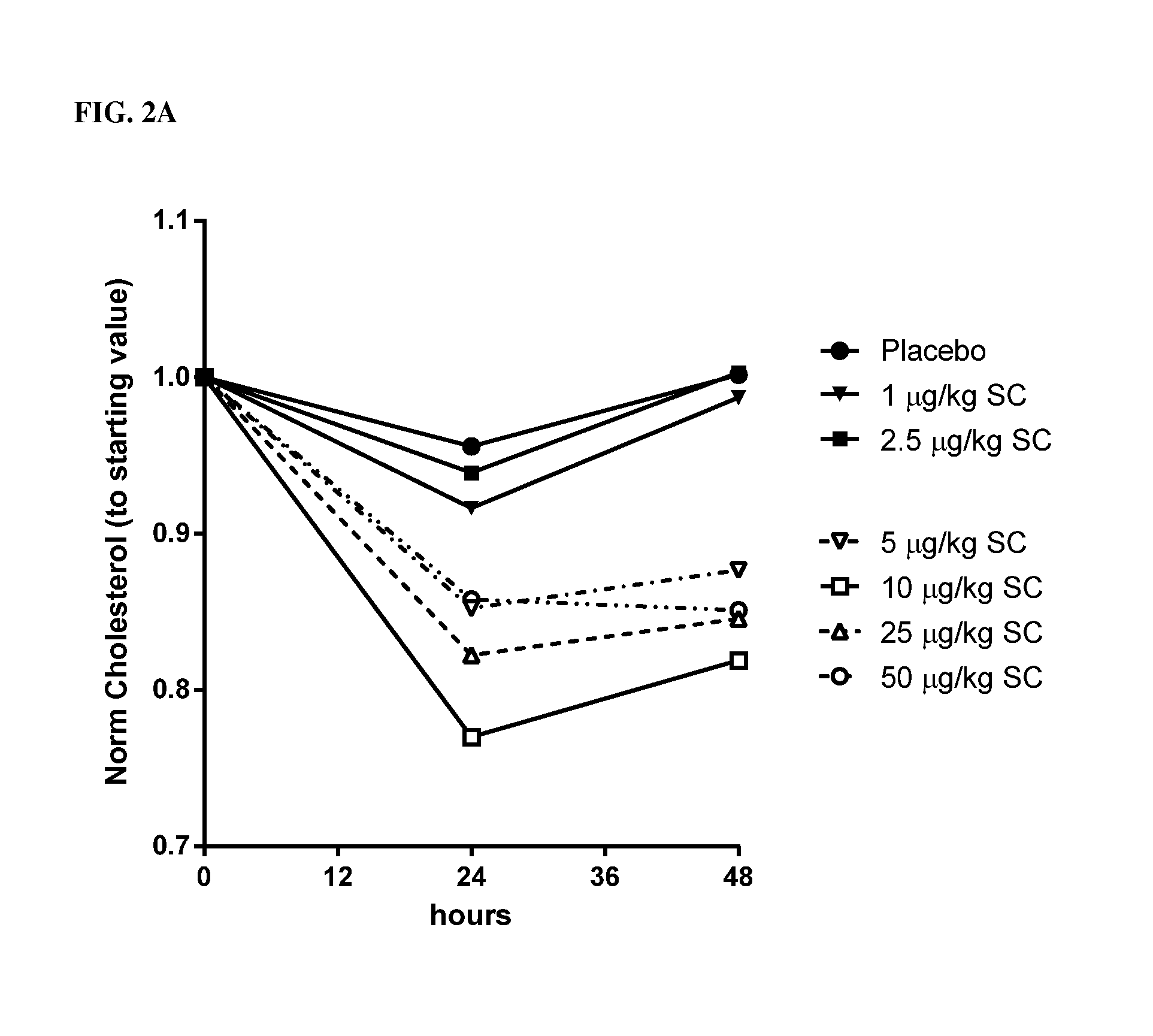Methods of Using Interleukin-10 for Treating Diseases and Disorders
- Summary
- Abstract
- Description
- Claims
- Application Information
AI Technical Summary
Benefits of technology
Problems solved by technology
Method used
Image
Examples
example 1
Effect of IL-10 Administered SC and IV on Pharmacodynamic Markers
[0321]The pharmacodynamic effects of SC and IV administration of rhIL-10 on total serum cholesterol (TC) and on the primary inflammation markers TNFα and IL-1β were evaluated in human subjects.
[0322]Subcutaneous Administration.
[0323]Single ascending doses of rhIL-10 (1.0 μg / kg, 2.5 μg / kg, 5.0 μg / kg, 10 μg / kg, 25 μg / kg and 50 μg / kg) were administered SC to normal, healthy human males (n≧6). TC was measured by conventional techniques 24 hrs and 48 hrs after administration. A 10% reduction in TC 48 hrs after dosing served as the benchmark for a pharmacologically relevant dose. As indicated in FIG. 2A (data are normalized to the starting values) and Table 1, rhIL-10 reduced the concentration of total serum cholesterol by ˜15%-23% at doses of 5 μg / kg, 10 μg / kg, 25 μg / kg and 50 μg / kg. Thus, doses greater than 2.5 μg / kg were pharmacologically relevant 48 hrs post-SC dose. As indicated in Table 1, 2.5 μg / kg resulted in an incr...
example 2
Cholesterol Reduction Following SC Administration of IL-10
[0332]The effect of subcutaneous administration of IL-10 on reduction of total serum cholesterol (TC) was evaluated in human subjects having liver fibrosis resulting from chronic hepatitis C.
[0333]Human subjects were divided into five treatment groups (19-13 males / group): placebo (administered both QD and TIW); 4 μg / kg IL-10 QD; 4 μg / kg IL-10 TIW; 8 μg / kg IL-10 TIW and 20 μg / kg IL-10 TIW. The duration of IL-10 (or placebo) administration for each treatment group was 24 weeks, and TC was measured weekly over a 28-week period. As indicated in FIG. 3, SC administration of 4 μg / kg IL-10 TIW resulted in TC reduction of ≧10% over the duration of the 24 week study. This finding supports the conclusion that a minimum total amount of IL-10 (administered SC) of ˜16 μg / kg / week is required to achieve the ˜10% threshold reduction in TC.
[0334]Particular embodiments of this invention are described herein, including the best mode known to th...
PUM
| Property | Measurement | Unit |
|---|---|---|
| Fraction | aaaaa | aaaaa |
| Fraction | aaaaa | aaaaa |
| Fraction | aaaaa | aaaaa |
Abstract
Description
Claims
Application Information
 Login to View More
Login to View More - R&D Engineer
- R&D Manager
- IP Professional
- Industry Leading Data Capabilities
- Powerful AI technology
- Patent DNA Extraction
Browse by: Latest US Patents, China's latest patents, Technical Efficacy Thesaurus, Application Domain, Technology Topic, Popular Technical Reports.
© 2024 PatSnap. All rights reserved.Legal|Privacy policy|Modern Slavery Act Transparency Statement|Sitemap|About US| Contact US: help@patsnap.com










